
Pulsing ultrasound waves to remove microplastics from waterways

Pulsing ultrasound waves could someday remove microplastics, which are potentially harmful to aquatic animals and plants, from waterways
Colourful particles of plastic drift along under the surface of most waterways, from headwater streams to the Arctic Ocean.
These barely visible microplastics – less than 5mm wide – are also potentially harmful to humans, so researchers are devising ways to remove them and stop them at their source.
Now a team from New Mexico Tech reports a two-stage device made with steel tubes and pulsing sound waves that removes most of the plastic particles from real water samples.
Principal investigator Menake Piyasena said: “The idea came from a discussion with a colleague who said that we need new ways to collect microplastics from water.
“Because acoustic forces can push particles together, I wondered if we could use them to aggregate microplastics in water, making the plastic easier to remove.”
Filtration is the most commonly used technique for removing these materials from water. For example, washing machine outlet filters can keep fibres that slough off clothes during washing from entering wastewater.
But this method can be costly on a large scale, requiring regular cleaning of the filters, which can get clogged.
Another option could be concentrating plastic particles in flowing water with acoustic forces, or sound waves, that transfer energy to nearby particles, causing some of them to vibrate and move.
Just think of a speaker playing loud music that shakes the ground, bouncing flecks of dust and dirt toward each other.
Scientists have already been using this phenomenon to separate biological particles from liquids, such as red blood cells from plasma.
Recently, some teams have applied this approach to the separation of microplastics from samples they prepared in the lab with pure water. But this work was done with tiny volumes of water.
They also used microplastics that were only tens of microns wide — smaller than the width of human hair, explains Nelum Perera, a graduate student in Piyasena’s lab at New Mexico Tech.
“I read that most of the microplastics in the environment are larger than that,” says Perera, who is presenting the work. “So, I wanted to develop a device that could be useful for most of the sizes and could be scaled up to meet real-world goals.”
See also: Unprecedented increase in ocean plastic revealed
Acoustic forces to microplastics
To accommodate higher water flow rates, Perera created a proof-of-concept device with 8mm-wide steel tubes connected to one inlet tube and multiple outlet tubes. Then she attached a transducer to the metal tube’s side.
When the transducer was turned on, it generated ultrasound waves across the metal tube, applying acoustic forces onto microplastics as they passed through the system, making them easier to capture.
The prototype device is relatively simple compared to traditional filtration methods, Piyasena explains, because it doesn’t clog as easily as a filter.
In initial experiments with polystyrene, polyethylene and polymethyl methacrylate microplastics, the researchers discovered that smaller (6- to 180µm-wide) particles behaved differently than the larger (180- to 300µm-wide) ones in the presence of acoustic forces.
Spiked into pure water, particles of both sizes arranged along the centre of the channel, exiting through the middle outlet, while clean water flowed out the surrounding outlets.
But if laundry detergent or fabric softener were added to the water, the larger particles focused toward the sides, exiting through the side outlets, and purified water out the middle outlet.
Real-world applications
Based on these results, the researchers set out to develop a system that could take advantage of these differing movements.
They connected two steel tubes in tandem: the first stage captured small microplastics less than 180 µm wide, and the water stream with the remaining larger microplastics went to the second stage to be cleaned.
Perera said: “We removed more than 70% of the small plastics and more than 82% of the large ones this way.”
To show that the two-stage system could work for real-world applications, Perera and Piyasena collected water from a pond on the New Mexico Tech campus and from the Rio Grande River.
They filtered all of the samples to remove large contaminants, leaving behind water that still contained dissolved substances that could have affected the separation. Next, they spiked the water with microplastics.
When the environmental water samples went through the acoustics device, plastic particles were removed as effectively as from pure water.
With this prototype, Perera estimates it would cost around seven cents to operate the current device for an hour and take around an hour and a half to clean one litre of water.
The team’s next step is to develop a system with wider tubes, or bundles of multiple tubes, and to try it on unspiked real-world samples, including ocean water and wastewater from washing machines.
Piyasena said: “We have shown that acoustic forces can be used to concentrate a wide range of microplastic sizes, and from here, we want to prove that this can be done on a larger scale with real samples that already have microplastics in them.”
The researchers presented their results at the 2023 spring meeting of the American Chemical Society.
Image: Microplastics naturally scatter in flowing water (left), but after turning on sound waves, the particles concentrate along the tube’s sides (right), making them easier to remove. © Menake Piyasena.















